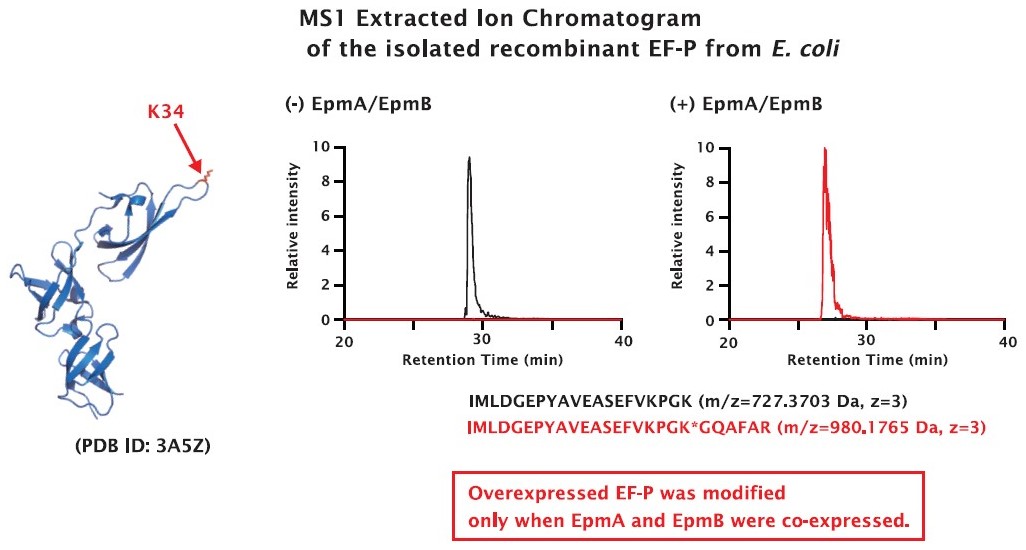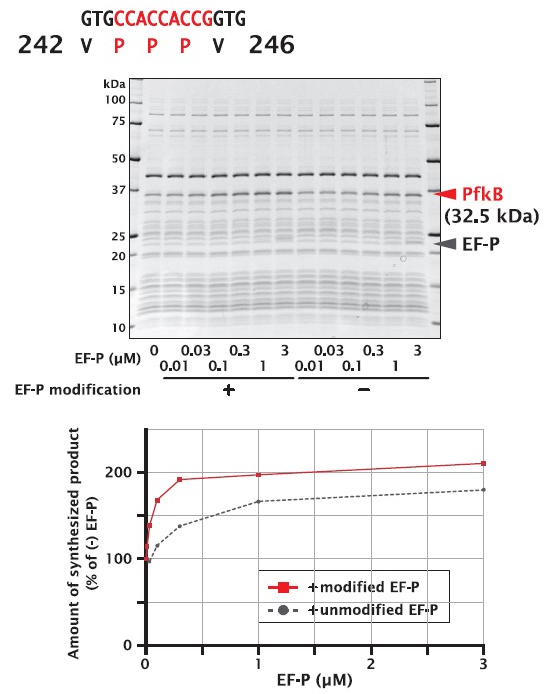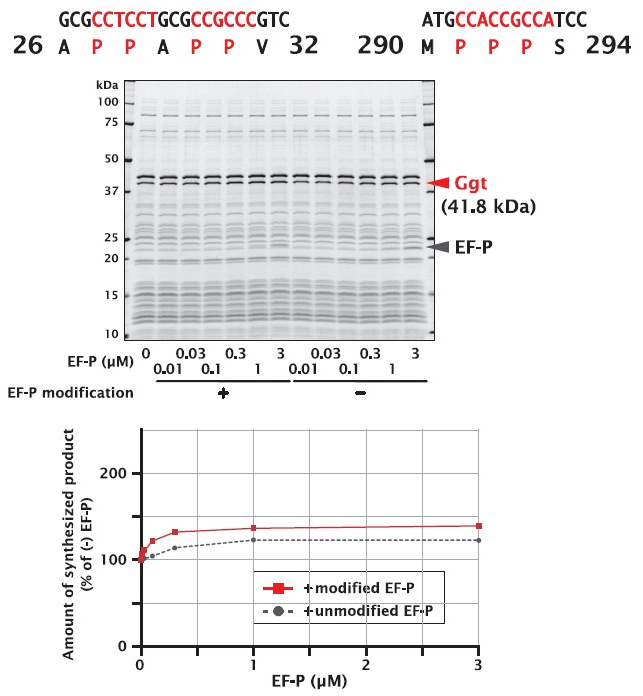When synthesizing proteins containing consecutive proline residue with PURE system (reconstituted cell-free protein synthesis system), the amount of protein synthesized tends to be small.
EF-P (elongation factor P) is one of the translation factors in Escherichia coli (E. coli) and a homolog of eukaryotic initiation factor 5A (eIF5A). EF-P improves the synthesis of protein containing consecutive proline residues such as Pro-Pro-Pro and Pro-Pro-Gly by promoting the formation of peptide bonds.
Here we show that EF-P contributes to increased synthesis of proteins containing consecutive proline residue.
1) About EF-P
Post-translational modification is important to the functionality of EF-P.
Lysine at 34th is post-translationally modified to β-lyslysine by EpmA (YjeA/GenX) and EpmB (YjeK). Regarding the effect of EF-P on translation efficiency, we used the modified EF-P and the unmodified EF-P added to the PURE system, and compared them in the amount of synthesis.

2) Methods
Template DNA: PCR product
Kits: PUREfrex® 2.0 (#PF201-0.25)
- Modified EF-P or unmodified EF-P was added to PUREfrex 2.0.
- Template DNA was added to the reaction mixture at a final concentration of 2 nM.
- The reaction mixture was incubated at 37 °C for 4 hours.
3) Synthesis of proteins containing proline stretches
3-1. Interleukin-6
This protein has PPG, proline stretches, at 3rd from the start codon.
In the case of the synthesis without EF-P, a short form product translated from the 5th amino acid Gly/Glu/Asp was synthesized. EF-P solved the problem of short form and consequently increased the amount of synthesis.
| Organism | Homo sapiens (Human) |
| Gene | IL6 |
| Synthesized region | 31 ‐ 212 (no signal peptide) |
| UniProt ID | P05231 |
| Length | 183 |
| Molecular weight | 23.1 kDa |
| No. of disulfide bonds | 2 |

3-2. ATP-dependent 6-phosphofructokinase isozyme 2
This protein has 3 consecutive proline residues.
The amount of PfkB synthesized was higher when EF-P was added than when EF-P was not added to the reaction mixture. In particular, the modified EF-P showed a higher effect than unmodified one.
| Organism | Escherichia coli (strain K12) |
| Gene | pfkB |
| Synthesized region | 18Lys – 185Asp (+FLAG-His6) |
| UniProt ID | P06999 |
| Length | 309 a.a. |
| Molecular weight | 32.5 kDa |
| No. of disulfide bonds | 0 |

3‐3. N-acetylmuramoyl-L-alanine amidase AmiB
This protein has 8 consecutive proline residues.
The amount of AmiB synthesized was higher when EF-P was added than when EF-P was not added to the reaction mixture. In particular, the modified EF-P showed a higher effect than unmodified one.
| Organism | Escherichia coli (strain K12) |
| Gene | amiB |
| Synthesized region | 23 ‐ 445 (no signal peptide) |
| UniProt ID | P26365 |
| Length | 423 a.a. |
| Molecular weight | 45.6 kDa |
| No. of disulfide bonds | 0 |

3‐4. Glutathione hydrolase proenzyme
This protein has multiple 2 or 3 consecutive proline residues.
The amount of Ggt synthesized was slightly higher when EF-P was added than when EF-P was not added to the reaction mixture.
| Organism | Escherichia coli (strain K12) |
| Gene | ggt |
| Synthesized region | 26 ‐ 390 (no signal peptide, large subunit) |
| UniProt ID | P18956 |
| Length | 365 a.a. |
| Molecular weight | 41.8 kDa |
| No. of disulfide bonds | 0 |

4) Synthesis of protein containing no proline stretches with EF-P
4-1. Dihydrofolate reductase
This protein has no consecutive proline residue.
It is also used as a positive control in PUREfrex kit because of the large amount of synthesis with PUREfrex.
https://www.genefrontier.com/solutions/dhfr_dna/
Protein synthesis using EF-P did not affect productivity.
| Organism | Escherichia coli (strain K12) |
| Gene | folA |
| Synthesized region | 1 ‐ 159 |
| UniProt ID | P0ABQ4 |
| Length | 159 a.a. |
| Molecular weight | 18 kDa |
| No. of disulfide bonds | 0 |

5) Conclusion
EF-P showed effect on increasing the productivity of proteins containing consecutive proline.
The characteristics of proteins in which the presence of consecutive prolines affects the amount of synthesis do not depend only on the number of consecutive prolines, but also on where they are in the sequence and on the type of surrounding amino acids.
It is recommended to add EF-P when synthesizing proteins with consecutive proline residue because addition of EF-P to reaction mixture was not found to inhibit protein synthesis.

